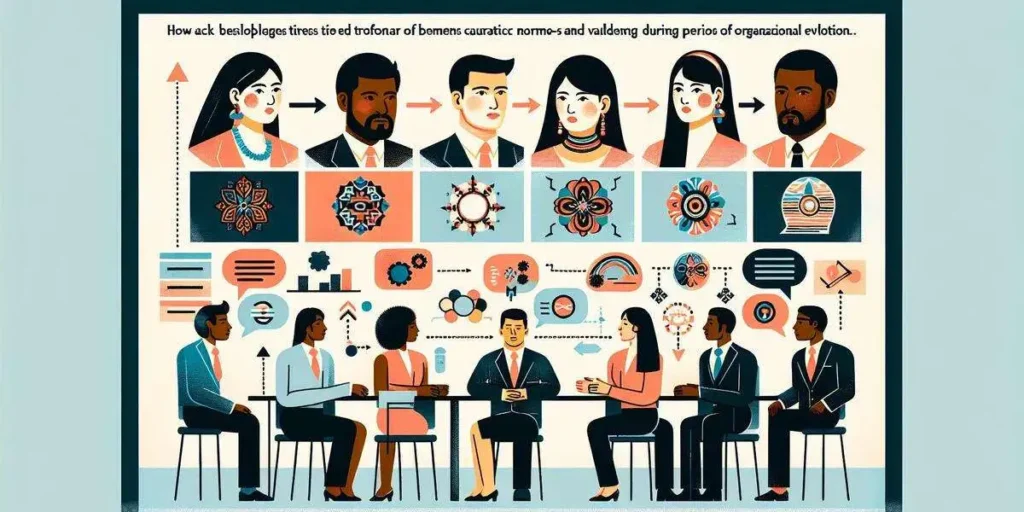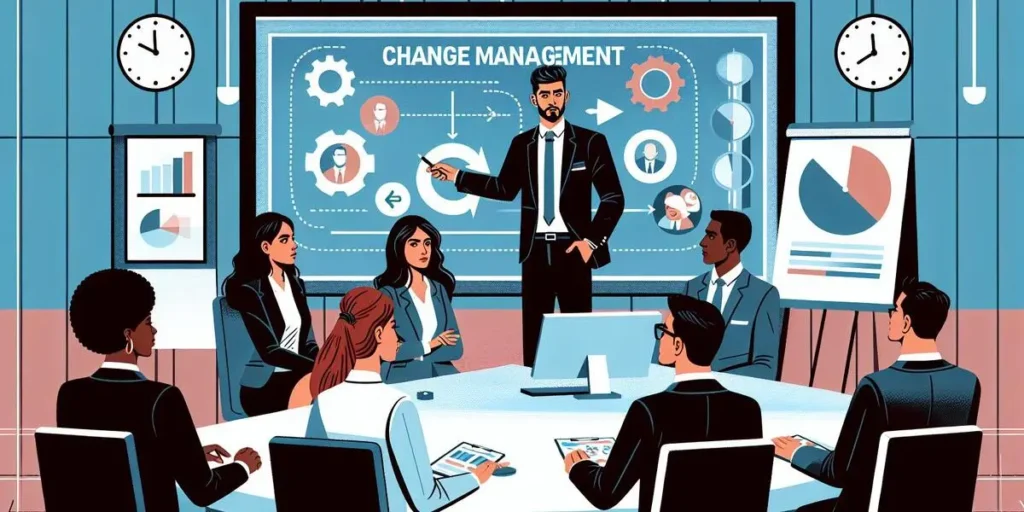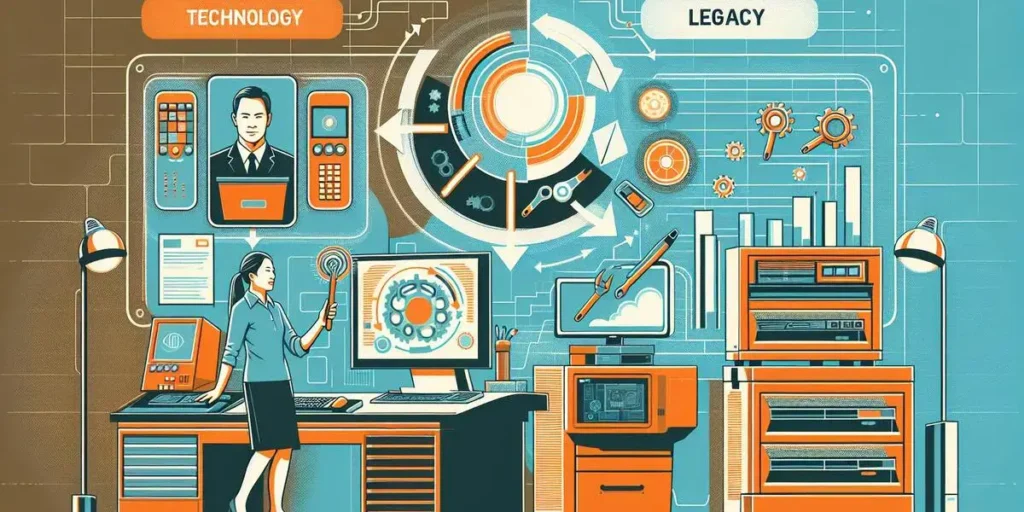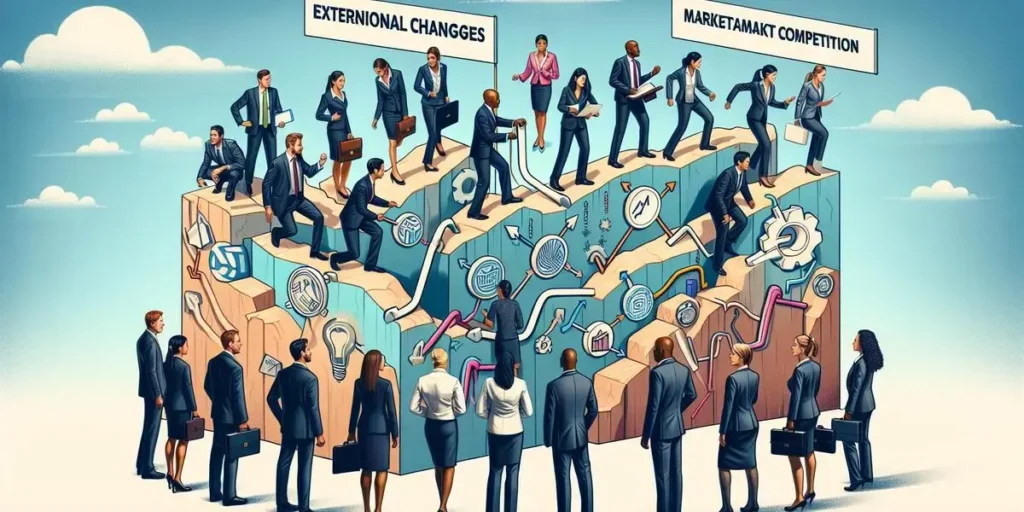Navigating the complex landscape of organizational change can feel like steering a ship through treacherous waters. Every company’s culture is laced with its own set of norms, values, and beliefs that can create formidable barriers to change. These entrenched elements are often the silent gatekeepers, holding back progress with an iron grip.
Technology, with its rapid pace, often outstrips our ability to adapt, leaving us grappling with outdated systems that resist integration or evolution. And let’s not forget the external forces like regulations, competition, and economic conditions that add another layer of complexity. Understanding these barriers is the first step toward developing a strategy that turns resistance into support.
Understanding the Barriers to Organizational Change
Recognizing the obstacles that can stall progress is a pivotal aspect of managing change within an organization. In my experience, wasted resources represent a significant barrier. Change consumes vast resources, including time and money. Without addressing these barriers effectively, valuable assets are squandered, which only compounds organizational strain. This is not just a financial burden but also an operational one, often resulting in strategic missteps.
Another crucial factor to consider is employee retention. Ill-executed change strategies lead to workforce burnout, which directly impacts staff turnover. Employee retention is tied to how successfully a change is implemented. If employees feel overwhelmed or undervalued during transitions, their likelihood of staying plummets.
Moreover, the damage to a company’s culture and reputation cannot be overstated. If change initiatives fail repeatedly, stakeholders lose confidence, which can erode investment opportunities. Protecting a company’s culture and reputation should be a top priority, as their deterioration has long-term negative effects.
Addressing Culture, Technology, and External Factors
A deep understanding of a company’s culture, including its norms, values, and beliefs, is necessary to navigate these barriers. Any strategy that neglects cultural considerations is likely to encounter stiff resistance.
Technology-related barriers are equally challenging, often rooted in proprietary software or systems that resist modification. Embracing the digital aspect of change requires careful planning to ensure compatibility with new technologies.
External factors such as regulations, competition, and economic conditions also shape the landscape of organizational change. Each demands a detailed analysis to mitigate the risks associated with external pressures.
| Barrier Type | Description |
|---|---|
| Wasted Resources | Undirected change efforts leading to financial and temporal losses |
| Employee Retention | Poor change management resulting in increased staff turnover |
| Company Culture & Reputation | Reputational damage due to unsuccessful change initiatives |
By identifying sources of resistance and rallying supporters, I can begin crafting a strategy that not only overcomes barriers but also positions the organization for positive, lasting transformation. Building a coalition of change advocates is essential for the effective execution and evaluation of any new initiatives. My aim is to transform resistance into engagement by meticulously planning and executing my change management strategy.
Cultural Barriers: Norms, Values, and Beliefs
When initiating changes within an organization, cultural barriers are often underestimated yet they wield immense influence over the success rate of new strategies. The deeply-rooted customs and traditions that constitute the backbone of a company’s culture can be resistant to alterations in course. Workplace norms, values, and beliefs don’t just evolve overnight; they’re built over time, and this is what makes them challenging to reconfigure.

For instance, if your company has always prioritized customer service above all else, introducing a drastic, efficiency-first approach may clash with employee perceptions of what’s truly important. This discord can create significant resistance to change as employees struggle to realign their own values with those being promoted by new organizational initiatives.
The complexities of these cultural barriers are magnified when considering the diversity of today’s workforce. With employees hailing from a range of backgrounds, their distinct perspectives can collide during the implementation of change. Those based on Hofstede’s 6-D Model show that variations in power distance, individualism, and uncertainty avoidance can greatly affect how change is perceived and enacted upon.
Further complicating matters is the human element—a vital dimension often overlooked during the planning stage. As per PwC’s research, 72% of leaders recognize that the softer side of work culture is essential for facilitating positive transformations. Yet, planners tend to undervalue how employees feel, reason, and collaborate. Ignoring emotions and intuitions is a misstep that can build an invisible wall against the acceptance of change. It’s crucial to recognize that an inclusive understanding of the multitude of views and sentiments within the workplace is the key to dismantling these cultural barriers. Only by addressing and integrating the fabric of our company’s human elements can we hope to maneuver through the impediments to change successfully.
Overcoming Resistance: Strategies to Break Through
Identifying resistance to change is one thing, but overcoming it requires a systematic approach. I’ll share some successful strategies to break through the resistance, each tailored to tackle specific barriers head-on.

Communication is key. By articulating a vision with crystal-clear clarity, you can dissolve doubt and rally individuals and teams around a common purpose. This goes beyond just conveying facts—it’s about painting a picture of the future that’s compelling and aligns with people’s values. A well-laid-out communication strategy can make the difference between confusion and confidence, ensuring that everyone’s rowing in the same direction.
Incentivization and Its Impact
Offering incentives is another powerful technique in your change management arsenal. By aligning rewards with desired behaviors, you can tilt the balance from resistance to acceptance. It’s a practical way to overcome hurdles like risk aversion and power struggles. A bonus, a promotion, or even recognition can serve as a catalyst for employees to embrace and drive the change.
Education and Training
Moreover, in-depth education and training can help demystify the change process. When employees understand not just the “what” but the “why” and “how,” it empowers them to contribute more effectively. Educational workshops and open forums for discussion are excellent tools to dispel myths and unite teams under the new directive.
Leveraging these strategies effectively requires strategic resource allocation. There’s no one-size-fits-all solution; what’s crucial is tailoring your approach to the unique challenges and culture of your organization. Keep in mind that successful implementation of change management strategies often hinges on an iterative process where feedback is used to refine and improve the tactics employed.
By using these strategies thoughtfully, you can begin to dismantle barriers, piece by piece—transforming resistance into momentum towards the transformative goals of your organization.
Technological Barriers: Adapting to the Rapid Pace of Change
In today’s business landscape, technological barriers stand among the most daunting challenges to organizational change. As the corporate world evolves, staying abreast of the latest technological developments is not just advantageous; it’s imperative. The exponential rate of innovation means that what’s cutting-edge today may be obsolete tomorrow. This rapid pace can lead to significant hurdles within an organization, particularly when it comes to integration and training.

I’ve observed that one of the major technological barriers is the resistance to the abandonment of legacy systems. Many companies have deeply embedded technologies that are intertwined with their operations. The cost and effort required to update these systems can be substantial and often, there’s an attachment to the familiarity and perceived reliability of existing systems. This attachment can stunt agility and responsiveness to new market demands.
Another critical aspect to consider is the digital literacy of the workforce. Even with the most advanced technologies at our disposal, the true potential of these tools is only realized when employees are proficient in using them. This underscores the importance of:
- Regular training sessions
- Updating skills
- Encouraging digital adaptation
Furthermore, cybersecurity concerns add another layer of complexity. As we implement new technologies, the risk of cyber threats increases. A robust strategy to safeguard against these threats is not optional; it’s a mandatory component of current change management practices. It requires a proactive approach to security protocols and continuous monitoring to identify and respond to vulnerabilities.
Ultimately, technological barriers in organizational change shouldn’t be viewed as insurmountable roadblocks, but rather as opportunities. Opportunities to innovate, to refine processes, and to empower employees. When tackled with strategic planning and alignment with overall business objectives, these obstacles can become catalysts for growth and efficiency. By educating myself on the latest trends and solutions, I’m better positioned to anticipate these barriers and work proactively to overcome them.
External Forces: Regulations, Competition, and Economic Conditions
When examining the multitude of hurdles faced by organizations, external forces frequently come into play, shaping the terrain on which companies operate. My experience tells me that regulatory compliance is often seen as a major obstacle. The need to adhere to ever-evolving government standards can be both time-consuming and costly. I’ve noticed that shifts in policy or regulation may require complete overhauls of existing processes, which can delay or derail initiatives intended to foster change.

Competition is another external factor that drives organizational change. Companies must stay one step ahead, or they risk falling behind. As markets evolve, the pressure to innovate mounts, and the failure to adapt can result in a loss of market share. Agility and responsiveness are critical in this context; however, they can also introduce strain as organizations strive to align their strategy with the market’s rapid fluctuations.
Economic conditions create a backdrop that cannot be ignored. Economic downturns may lead to budget cuts and resource constraints, limiting an organization’s ability to invest in change. Conversely, economic booms can present opportunities for expansion but come with their own set of challenges such as scaling operations or managing increased demand.
In grappling with these external forces, it’s vital to maintain a delicate balance between proactive adaptation and maintaining core operational stability. Strategic forecasting and risk management are essential tools that can help organizations navigate these choppy waters effectively. By planning for various scenarios and being prepared to pivot when necessary, companies can address the barriers imposed by regulations, competition, and economic conditions while fostering an environment conducive to positive change.
Conclusion: Turning Resistance into Support
Navigating the waters of organizational change is no small feat. I’ve seen how embracing technological shifts, fostering a culture of continuous learning, and staying ahead of external challenges can transform resistance into support. It’s about striking the right balance—leveraging innovation while maintaining the core of what makes an organization successful. By staying vigilant and adaptable, I’m confident that any business can overcome the hurdles of change and emerge stronger on the other side. Remember, it’s not just about facing change but mastering the art of transformation.
Frequently Asked Questions
What technological challenges impede organizational change?
Technological challenges involve keeping up with rapid advancements, the reluctance to replace legacy systems, and the need for cybersecurity measures. To overcome these, organizations must focus on continuous training and encourage digital adaptation.
Why is regular training important for navigating organizational change?
Regular training is vital because it updates employee skills to match evolving technology and industry standards, which is essential for the successful implementation of organizational change.
How does resistance to abandoning legacy systems affect change?
Resistance to abandoning legacy systems can stall progress, as outdated technology may not support new processes or meet current market demands, leading to inefficiencies and competitive disadvantage.
What proactive approach is needed for cybersecurity in organizational change?
A proactive approach to cybersecurity involves regular updates, implementing robust security protocols, and training employees to recognize threats, ensuring the protection of sensitive data during change processes.
How do external factors like regulations, competition, and economic conditions create barriers to change?
Regulations can impose additional compliance costs; competition may require rapid adaptation; economic fluctuations can lead to budget constraints. These factors can limit an organization’s flexibility and resources for change.
What is the importance of strategic forecasting in organizational change?
Strategic forecasting helps organizations anticipate future trends, assess risks, and prepare for change, enabling them to make informed decisions and maintain operational stability while adapting to new circumstances.
How can organizations overcome resistance and facilitate positive change?
Organizations can aid change by involving employees, communicating effectively, providing necessary resources, and creating a culture that is open to change. REDUCE framework and evidence-based persuasion can also be effective tools.
